THIRD INTERNATIONAL
ORGAN
AND EARLY MUSIC FESTIVAL
OAXACA , MEXICO
NOVEMBER 13 - 17, 2003
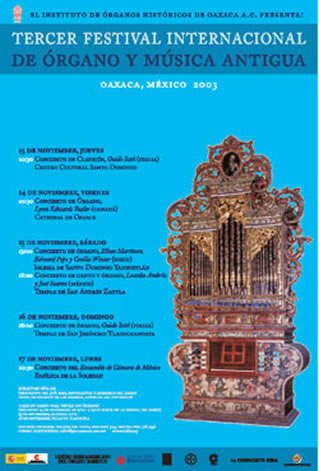
The First and Second IOHIO Festivals presented not only organ concerts and field trips, but also conferences and discussions on the pressing theme of organ conservation and restoration. Adding another dimension to the musical fare enriched the Festival immensely and made it even more attractive to potential participants, so we decided to continue this trend.
For the Third Festival we did not define a secondary theme as such, but rather just broadened the scope of the activities to celebrate the organs as part of the rich cultural panorama of Oaxaca. The state of Oaxaca is perhaps the most culturally diverse in Mexico and has long been appreciated for its archaeological sites, colonial history and architecture, handicrafts and local cuisine, as well as its climate and ecological diversity. But it is only in recent years that the antique pipe organs (sixty-four of them registered to date) have been recognized as yet another fascinating aspect of the Oaxacan patrimony.
Most organ festivals around the world depend on the support of their local communities. These events may present concerts on just one or two instruments which may be scheduled over the course of several weeks or months. In Oaxaca however, the situation is different. Community awareness of the organs is still developing, and it is the national and international organ aficionados living outside Oaxaca who have demonstrated the most interest in attending the IOHIO festivals. For this reason, we offer a package for organ tourists. Compressed in time and rich in scope, this package tries to showcase as many of our organs as possible in the allotted time. Those who travel from afar will of course hope to enjoy as much of the local culture as possible during their stay, and for this the organs provide a special and unusual “hook.” For example, most organs are located in villages outside the city and just getting there and being there means that organ tourists will see not only the organs but also the people, the church, and the geographical area, and sometimes even sample the cuisine.
This year´s festival offered five concerts on five different restored Oaxacan instruments, as well as one harpsichord concert; two all-day field trips to visit four unrestored organs in the Mixteca Alta and the Mitla Valley; the opportunity for visiting organists to play three of the five organs after the concerts; two sumptuous meals in local communities; guided tours of several 16th century churches and the archeological site of Monte Albán; a visit to the Tlacolula market; and on-site talks about the organs, their construction and their restoration. This rich and varied cultural experience, with the organs as the base, proved to be so enticing, that it will influence all future festival planning.
The first two festivals featured the organ as a solo instrument, but this year the organ was presented as an ensemble instrument as well, so that some concerts included singers and other instruments. To reflect this more diverse programming, the title of the Festival was changed from “International Festival of Organ Music” to “International Organ and Early Music Festival.”

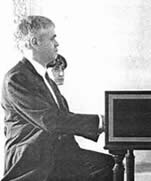
November 13. The Festival was inaugurated in the 16th century former convent next to the Santo Domingo church. Italian keyboardist Guido Iotti offered an elegant harpsichord concert of works by 18th century Italian, French and German composers. The audience was enchanted by his playing, and after the concert people were overheard making their plans to attend his organ concert in Tlacochahuaya three days later. The acoustics in the imposing stone cloister are extraordinary, and the delicate sounds of the harpsichord could be heard perfectly in this monumental space.
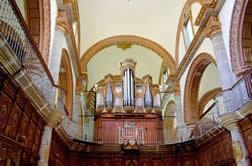 November 14. Canadian organist Lynn Edwards Butler offered the Second Concert of the Festival in the Oaxaca Cathedral. Entitled “Devotion to the Virgin,” more than half the pieces centered on this theme. Edwards Butler has been involved with the IOHIO since its founding and this is the second concert she has played in Oaxaca—an honor for all music lovers in the community. Her program presented pieces by the principal 17th century Spanish composers, as well as German works which included two plainsong chants from 16th century manuscripts. These were sung in alternation with the organ by tenor Israel Rivera Perez and the listening experience was at times sublime. Unfortunately however, local celebrations were blasting away right near the church and the noise interfered maddeningly with the beauty of the more transparent works. November 14. Canadian organist Lynn Edwards Butler offered the Second Concert of the Festival in the Oaxaca Cathedral. Entitled “Devotion to the Virgin,” more than half the pieces centered on this theme. Edwards Butler has been involved with the IOHIO since its founding and this is the second concert she has played in Oaxaca—an honor for all music lovers in the community. Her program presented pieces by the principal 17th century Spanish composers, as well as German works which included two plainsong chants from 16th century manuscripts. These were sung in alternation with the organ by tenor Israel Rivera Perez and the listening experience was at times sublime. Unfortunately however, local celebrations were blasting away right near the church and the noise interfered maddeningly with the beauty of the more transparent works.
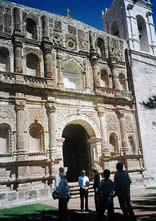
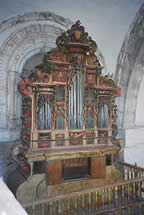
November 15. One of the highlights of the Festival was the all day field trip to the Mixteca Alta, the geographical region of Oaxaca with the highest concentration of restored and unrestored organs. The first of our three stops was in Santa María Tiltepec, whose 17th century church is renowned for the juxtaposition of European and indigenous motifs carved on its asymmetrical façade. The 18th century 4´ organ is unique in Oaxaca for its capricious decoration, beautifully carved keyboard, and unusual details of construction.
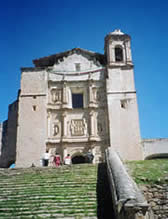 The Third Concert of the Festival took place in the 16th century church of Santo Domingo Yanhuitlán. Restored in 1996 by French organbuilder Pascal Quoirin, the organ case and pipes are lavishly decorated with fanciful designs and Dominican symbols. The concert was a collaborative effort by local organists Eliseo Martínez García, Ed Pepe and Cicely Winter on one of Oaxaca´s earliest (ca. 1700) and most stunning organs. Winter opened the program with pieces by Cabanilles and Frescobaldi and was followed by Martinez playing transcriptions of well-known pieces by Bach, Handel, Clerambault and Corelli, some with trumpet accompaniment by Alfredo Ruiz. Ed Pepe offered three tientos by Portuguese composers Carreira and da Conceicao and one by Correa de Arauxo, followed by two pasacalles by Frescobaldi and Cabanilles. His interpretations were masterful, eliciting thrilling sounds from the organ. The concert ended with Winter playing two Oaxacan folk songs, Dios Nunca Muere and La Canción Mixteca. Song sheets had been distributed so the audience, including many people from the local community, could sing along. The Third Concert of the Festival took place in the 16th century church of Santo Domingo Yanhuitlán. Restored in 1996 by French organbuilder Pascal Quoirin, the organ case and pipes are lavishly decorated with fanciful designs and Dominican symbols. The concert was a collaborative effort by local organists Eliseo Martínez García, Ed Pepe and Cicely Winter on one of Oaxaca´s earliest (ca. 1700) and most stunning organs. Winter opened the program with pieces by Cabanilles and Frescobaldi and was followed by Martinez playing transcriptions of well-known pieces by Bach, Handel, Clerambault and Corelli, some with trumpet accompaniment by Alfredo Ruiz. Ed Pepe offered three tientos by Portuguese composers Carreira and da Conceicao and one by Correa de Arauxo, followed by two pasacalles by Frescobaldi and Cabanilles. His interpretations were masterful, eliciting thrilling sounds from the organ. The concert ended with Winter playing two Oaxacan folk songs, Dios Nunca Muere and La Canción Mixteca. Song sheets had been distributed so the audience, including many people from the local community, could sing along.

After the concert, organists in the group were thrilled to have the opportunity to play one of Oaxaca´s oldest and most important organs in the dramatic vaulted space of the Yanhuitlán church.
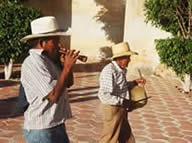
We then proceeded to San Andrés Zautla where we were welcomed by the local brass band, necklaces of purple bugambilia flowers and plenty of mezcal. The local women had prepared a luscious dinner of estofado, a regional stew, which was served in the patio behind the church.
Afterwards, we gathered in the lovely church with its baroque altarpieces and paintings to hear the Fourth Concert of the Festival by Mexico City artists, soprano Lourdes Ambriz and organist José Suárez. Suárez is the leading Mexican performer of the historic organ repertoire and Ambriz´s voice is often described as celestial. Their serious and profound program consisted of works by Italian and German composers of the 17th and 18th centuries.
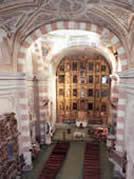 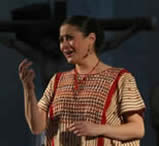 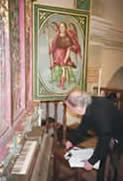
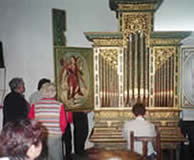
Once again attending organists had the opportunity to play the organ after the concert. This 4´ organ (1726) could stand as a work of art in its own right. Elaborately decorated with images of saints and archangels on all its surfaces, it was restored by Susan Tattershall in 1996.
November 16. Our second field trip of the weekend took us to four organs, three of them unrestored, in the Valley of Oaxaca. We began our tour with a visit to San Matías Jalatlaco, just on the edge of Oaxaca City. This lovely blue organ, though incomplete, is one of the few bearing an inscription (on the interior of the keydesk) with the date of construction—1866—and the builder´s name—Pedro Nibra, who was one of Oaxaca´s great 19th century organbuilders.
 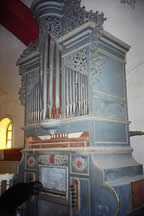
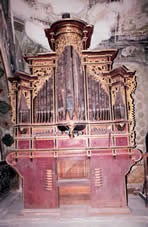 The next stop was at the Sunday market in Santa María Tlacolula, which for centuries has been the main commercial center for this Zapotec area of Oaxaca. Everyone The next stop was at the Sunday market in Santa María Tlacolula, which for centuries has been the main commercial center for this Zapotec area of Oaxaca. Everyone 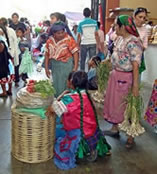 dispersed for an hour to explore the market and admire the people, their costumes and their goods brought in from the surrounding villages. Afterward we met at the church and visited the extravagant baroque side chapel, then ascended the winding stone staircase to view one of Oaxaca´s most outstanding unrestored mid-18th century organs. Its upper case is elaborately carved and gilded in baroque style, butmost arresting of all are the finely painted faces, the most exquisite in all of Mexico, on the façade pipes. dispersed for an hour to explore the market and admire the people, their costumes and their goods brought in from the surrounding villages. Afterward we met at the church and visited the extravagant baroque side chapel, then ascended the winding stone staircase to view one of Oaxaca´s most outstanding unrestored mid-18th century organs. Its upper case is elaborately carved and gilded in baroque style, butmost arresting of all are the finely painted faces, the most exquisite in all of Mexico, on the façade pipes.
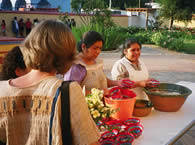
From Tlacolula we traveled to San Andrés Huayapam for our midday meal. The local women had set up tables in the atrium of the church heaped with platters of segueza (cracked corn mole), higaditos (egg and meat dish) and tejate (corn meal and cacao drink) which are the typical fiesta dishes for this part of the Oaxaca Valley.
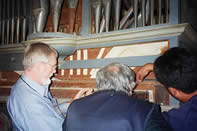
We were honored to have with us organbuilders Christoph Metzler (Switzerland) and Fritz Noack (USA). Noack, president of the International Society of Organbuilders (ISO), addressed the group and congratulated the IOHIO on its work and specifically on its caution in avoiding unnecessary interventions.
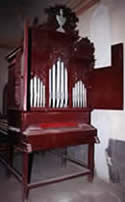
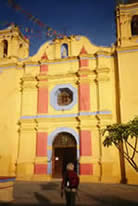
The church of Huayapam is a jewel and its baroque retablos have been recently restored. The organ (1772) is located in a raised side chapel to the right of the main altar. It is one of the last organs in Oaxaca with religious decoration—a chalice on its crest. It used to be painted bright red but was repainted a darker burgundy color probably in the late 19th century in accordance with the cooler more serious neo-classic aesthetic.

We left Huayapam in the late afternoon and proceeded to San Jerónimo Tlacochahuaya for the Fifth Concert of the Festival, presented by Guido Iotti. Before his concert, he spoke to the audience about Spanish and Italian organs and their repertoire. The concert which followed was divided into two sections, the first of which consisted of 16th and 17th c. Spanish and Italian works. This was followed by a selection of 18th c. Italian sonatas, exuberant in character and with occasional flourishes from the pajaritos register.
 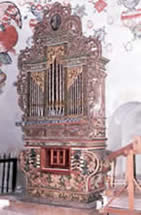 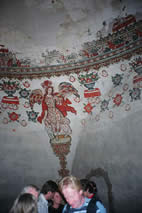
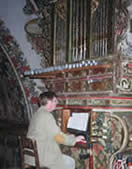
After the concert, those interested in seeing the organ up close climbed up to the choir loft and once again, organists from the group were allowed to play their prepared pieces, thus extending the musical experience for the audience below. The evening concluded under the stars in the atrium of the church where local women had set up tables of regional delicacies and everyone could enjoy the lovely night air and the good spirits engendered by the success of the Festival.
November 17. INAH (Instituto Nacional de Antropología e Historia) archeologist Marcus Winter offered a guided tour of the archeological site of Monte Albán. One of the most ancient cities of the New World, its hilltop location affords a stunning view of the surrounding valley
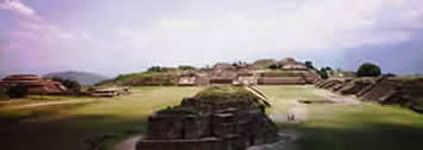
That evening everyone congregated in the Basílica de la Soledad for the Sixth Concert of the Festival. The Ensamble de Cámara de México, directed by Juan Ignacio Corpus, specializes in the Spanish and Mexican baroque repertoire. The ensemble, comprised of six singers, a cellist, a baroque guitarist, and an organist, presented a selection of choral works in Latin and Spanish, with one in Nahuatl, as well as music from manuscripts in the archives of the Oaxaca Cathedral. Organist Rafael Cárdenas accompanied the group and also played several solos by 17th century Spanish and English composers. This final concert of the Festival, full of contrasting sounds, textures, and moods, brought the Third Festival to a jubilant conclusion.
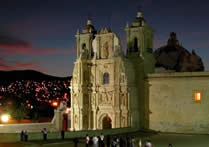 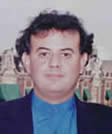 
Three of the six concerts were filmed by the local television station (Canal 9) and transmitted state wide immediately after the Festival. Transmission will continue throughout the year. This is the most effective way to bring the organs to the attention of the general public, since most Oaxacans don´t attend the concerts but they do see them on TV.
This was the first festival in which participating organists were invited to play the organs after the concerts. In this way, the audience got to hear even more marvelous music, and organists especially interested in Spanish organs and the 17th c. repertoire had a chance to know some of the Oaxacan organs first hand.
The Festival grew this year to include more organ-related activities than ever, all packed into five intense days. And there are still more options to explore. For this reason, we are considering dividing next year´s festival into two parts. The first part will concentrate on visits to restored and unrestored organs and is tentatively scheduled from Nov. 20 – 22, 2004; the second part will focus on concerts and master classes and is tentatively scheduled for the second half of February 2005. This way each aspect will have a chance to flourish and participants will be able to enjoy more organ activities than ever.
To read the report by David Warren Steel about the festival click here
The IOHIO is grateful for the support of the following institutions:
Consejo Nacional para las Artes y la Cultura (CONACULTA)
Instituto Nacional de Bellas Artes (INBA)
Instituto Nacional de Antropología e Historia (INAH)
Instituto Oaxaqueño de las Culturas (IOC)
Fideicomiso Oaxaca Sicarú, A.C.
Fomento Social Banamex
Centro Cultural Santo Domingo
Corporación Oaxaqueña de Radio y Televisión (CORTV)
Universidad de Valladolid
Agencia Española de Cooperación Internacional (AECI)
Caminos y Puentes Federales (CAPUFE)
We are also grateful for the support of the following Oaxacan businesses.
Hotel Maela
Hotel Roma
Proveedora Gráfica de Oaxaca
|

